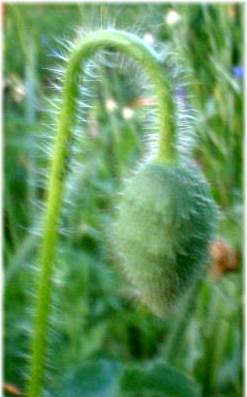|
Gardens Ablaze |
||
|
|
Poppy |
|
|
Additional Poppy Information
Medicinal Uses Site Map
Home
|
We have all heard of the opium poppy (papaver somniferum), which has been used medicinally for centuries, and which incidentally is illegal to grow in most areas (see more on this type of poppy in the medicinal section). The plant is an annual that sports large, attractive flowers that bloom in the spring. Flowers colors range from purple to pink to deep red, and variegated specimens are not uncommon. The flowers forms include single, double, semi-double, peony flowered, and tulip flowered types, to name just a few. These are very nice garden flowers, and in that respect it is a shame that they cannot be enjoyed in the garden. Fortunately for us, there are other types of poppies that are just as beautiful and easy to grow, and don't carry the stigma that the opium poppy is burdened with.
Iceland poppies (Papaver nudicaule) are also grown as annuals and sport fragrant, delicate orange, white, red, pink, or peach-colored flowers that are up to 3 inches across on 2 foot stems.
The California poppy (Eschscholzia californica) is a native orange, gold, or yellow wildflower in California and the southwest that blankets hillsides with color from spring until the first frost. It is a tender perennial that self seeds freely, explaining its success in the wild. The petals close at dusk and on dark days, but while they are open, the plant appears to radiate energy. The Mexican Poppy or Mexican Prickly Poppy (Argemone Mexicana) has big white or yellow flowers with thistle-like seeds. It grows wild in the temperate areas of the southern US and Mexico, and favors full sun and dry conditions. It self seeds freely and can become a pest if left unfettered.
Poppies attract birds, bees, and beneficial insects, and as such as an excellent choice for a habitat-type situation. They are wonderful in drifts by themselves and also add bright color to the perennial garden. Single varieties lend themselves well to pressing, and the interesting seed pods make great additions to flower arrangements and craft projects. Poppy seed is a common ingredient in baking, and throughout history these plants have been harvested for their medicinal qualities. Please see the link below for more information on this aspect of this amazing plant.
Custom Search
|
|
|
Gardens Ablaze |
||
 Poppies
are a time-tested gardening favorite. For showy bloom, that can be
seen from a long way off, easy care, interesting-looking flower buds, and
geometric-design seed pods for flower arrangements, there's really no substitute
for them in the home landscape.
Poppies
are a time-tested gardening favorite. For showy bloom, that can be
seen from a long way off, easy care, interesting-looking flower buds, and
geometric-design seed pods for flower arrangements, there's really no substitute
for them in the home landscape. 
 All
poppies need the same basic care in the home garden setting. Well-drained
soil is at the very top of the list, as these plants will decline rapidly
in overly wet conditions. Full or nearly full sun is another requirement
for success with these plants, but otherwise all the poppy varieties are
incredibly easy to grow in the home garden - and the return is a spectacular
show. The perennial varieties can be propagated by root division in
the fall, and seed for any variety can be sown either in fall or very early
spring - most need some frost to germinate properly. Some poppies
resent transplanting, so if at all possible, sow poppy seeds where you want
the plants to grow.
All
poppies need the same basic care in the home garden setting. Well-drained
soil is at the very top of the list, as these plants will decline rapidly
in overly wet conditions. Full or nearly full sun is another requirement
for success with these plants, but otherwise all the poppy varieties are
incredibly easy to grow in the home garden - and the return is a spectacular
show. The perennial varieties can be propagated by root division in
the fall, and seed for any variety can be sown either in fall or very early
spring - most need some frost to germinate properly. Some poppies
resent transplanting, so if at all possible, sow poppy seeds where you want
the plants to grow.